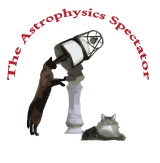
The basic layout of the site is as survey paths, which can be found under the Surveys link at the top of this and most other pages on this site. Each survey begins with a basic overview of the subject. Part of this overview include simulators of astrophysical phenomena that allow the reader to experiment with the phenomena. The later pages in a survey present the subject in greater and more mathematical depth. A path ends with research pages that describe current research projects and results in astrophysics.
The links at the top of each page are Home, which is the current home page of this site, Commentary, which is an index of short essays on topics loosely related to astrophysics, Surveys, which is the index of survey paths, Research, which is the index of research pages and the page leading to recent news items, Background, which is the index page for all background information on astrophysics, including survey pages, simulator pages, tables, bibliographic references, and lists of web resources, Previously, which is an index of previous home pages, and Site Info, which describes the site and its author, and gives contact information.
On the home page is found an addition link. This is the Store link, which leads to reviews of worthwhile books on astronomy and other relates subjects. Links on these pages enable the reader to buy these books from Amazon.com, which helps to financially sustain this web site.
On Wednesday of every fortnight, a new issue of The Astrophysics Spectator is published that comprises a new home page, a new commentary, whatever news the author notices, and background, research, and simulator pages added to the survey paths. The home page acts as an index to the newly added pages. This site also has an RSS channel, whose link is given at the bottom of the right-hand column of this page.
November 16, 2005
This week in The Astrophysics Spectator I expand the discussion of stellar gravitational lenses and how they are used to find low mass stars and Jupiter-sized bodies within our Galaxy. These pages are part of the “General Relativity” survey path.
The simplest gravitational lens encountered in astronomy is the lens created by a star or a planet. Such a lens is called a point gravitation lens, because the object creating the lens can be treated as a point of mass rather than as an extended body. A point gravitational lens can magnify more distant objects, making them appear much brighter than they would without the lens. Every star in our Galaxy of 1012 solar masses creates such a gravitational lens, but each of these lenses covers such a tiny area of the sky that the total sky coverage of the sky by all of these lenses is itself a tiny fraction of the full sky.
Gravitational lenses within the Galaxy provide us with a tool for detecting stars that are too dim to see. Much of the mass of our Galaxy is invisible; we only know it exists from its contribution to the Galaxy's gravitational field. One of the important questions in astronomy is whether this “missing mass” is bound to low mass stars or Jupiter-size bodies. If it is, then these invisible bodies will fill the Galaxy with their gravitational lenses. If one of these lenses passed in front of a bright star in another galaxy, the lens will make the star appear more luminous. If we can find many instances of this effect, we can estimate the amount of matter in the galaxy that is contained in low mass stars, brown dwarfs, and Jupiter-like bodies.
While simple in principle, the actual search for stellar gravitational lenses in our Galaxy requires an automated telescope that can measure the magnitude of millions of extragalactic stars every night and compare them to earlier observations. The first such automated telescopes were built and placed into service two decades ago. With these systems a number of gravitational lenses have been found.
Publication Notice. The next issue of The Astrophysics Spectator is slated for November 30. This will be the last issue of 2005.
Background
Gravitational Lenses. This introductory page describes gravitational lenses in astrophysics. The gravitational field of every object in the universe can act as lens, but not all of these lenses produce observable effects. The most striking and common lenses in the universe are associated with clusters of galaxies. The stars within our own Galaxy act as lenses, but they rarely produce an observable effect. This page leads into a series of pages that describe the specifics of gravitational lenses. (continue)
Galactic Gravitational Lens Search. While the Galaxy is filled with gravitational lenses, the area on the sky covered by each lens is tiny, so that there is little chance that any one lens is magnifying a more distant source. But with current computers, automated telescopes can examine millions of extragalactic stars every evening to find those few stars that are magnified by a galactic gravitational lens. Such searches can measure the invisible mass of the Galaxy that is trapped in low mass stars, brown dwarfs, and Jupiters. (continue)
Update
Point Gravitational Lenses. The introductory material on gravitational lenses has been removed from this page and placed on its own page. The discussion that remains on the gravitational lens produced by a star has been extended. (continue)
Point Gravitational Lens Simulator. This simulator has been modified to allow control from the keyboard. The position of the gravitational lens relative to the more distant light source can now be controlled with the arrow keys. (continue)

RSS Channel
